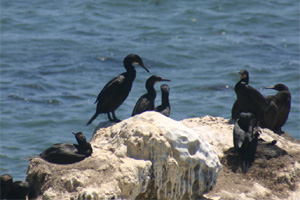- From January to March 2005 an unusually high number of Cassin’s and Rhinoceros Auklets, Common Murres, and Brandt’s Cormorants were reported washed up on central California beaches.
- From April to May 2005 a second wave of Common Murres and Brandt’s Cormorants were reported washed up on central California beaches.
- The majority of specimens collected and autopsied were emaciated and had no contents in their stomachs.
- It is believed that physical environmental factors, such as reduced upwelling, limited the food supply of these pelagic seabirds.
During January to February 2005, beached bird survey programs in central California reported increased deposition of several pelagic seabird species including Cassin’s and Rhinoceros Auklets in the Monterey Bay area (MBNMS Beach Combers) and Common Murres and Brandt’s Cormorants north of Monterey Bay (GFNMS Beach Watch). Tufted and Horned Puffins which are typically rare species were also encountered during Monterey Bay area surveys during this time. The timing of this mortality of these species was earlier than usual, and the magnitude of deposition was greater than in other years surveyed, with the exception of the 1997-1998 El Niño (1997 to 2004).
During April to May 2005, beach surveys reported increased numbers of beached Common Murres and Brandt’s Cormorants. State, federal and local agencies collected seabird carcasses to determine the cause of this mortality. Brandt’s Cormorants comprised the greatest proportion (67%, n = 39) of seabirds submitted for necropsy. With the exception of one specimen, all examined birds were moderately to severely emaciated, had no subcutaneous fat, low body masses, atrophied livers, atrophied pectoral muscles, and empty stomachs.
Starvation was found to be the primary cause of death in the majority of birds examined. Mature, breeding-aged adult cormorants and murres were affected as well as immature individuals suggesting severe food limitation. Ultimately, physical environmental factors, such as reduced upwelling favorable winds and resulting reduction in oceanographic conditions are likely responsible for the reduced productivity in the region.
Information on this event taken from a report submitted to the Monterey Bay National Marine Sanctuary by the Beach COMBERS program in June 2005.
Download the entire BeachCOMBERS report: Click here (275 KB PDF)
Find more information on the Beach COMBERS program:
http://www.sanctuarysimon.org/monterey/sections/beachCombers/index.php?l=n
